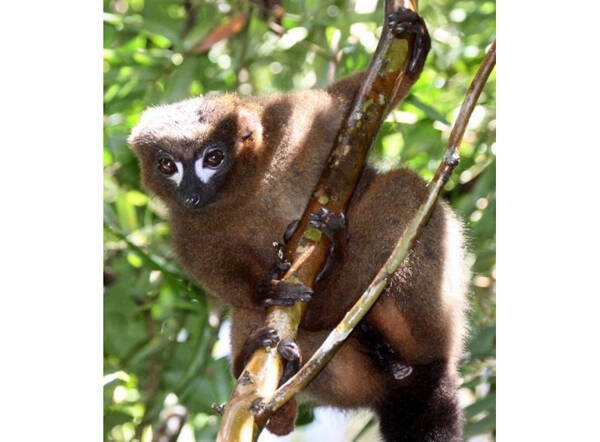Eulemur rubriventer
IUCN
LCBasic Information
Scientific classification
- name:Eulemur rubriventer
- Scientific Name:Eulemur rubriventer,Red-bellied Lemur,Red-bellied lemur
- Outline:Primates
- Family:Lemuridae Lemuridae
Vital signs
- length:35-40cm
- Weight:1.6-2.4kg
- lifetime:20-25years
Feature
The upper body of both sexes is dark chestnut brown, the lower body of the masculinized male is dark chestnut brown, and the lower body of the female is milky white.
Distribution and Habitat
The red-bellied lemur has a clearly discontinuous distribution and is endemic to Madagascar. It lives in the southern part of the tropical rainforest zone east of Andringitra, north of the Tsaratanana massif. It is absent on the Masoala Peninsula.
The red-bellied lemur inhabits tropical rainforests, found in moist montane forests and dry deciduous forests. The lemur is arboreal, spending most of its time in the upper layers of the tree canopy.
Appearance
The red-bellied lemur is one of the rarest species of the genus Lemur. The total length is 78-99 cm, the head and body length is 35-40 cm, the tail length is 43-51 cm, and the weight is 1.6-2.4 kg. It has some common characteristics among the same genus. The tail is longer than the body length, the tail hair is dense and long, and mostly broom-shaped; the eyes are large; the hair is dense and brightly colored; the snout of large species is extended, shaped like a fox mouth; the outer ear shell is semicircular, or the hair is dense; the hind limbs are longer than the forelimbs, and the fingers and toes have flat nails and 36 teeth. The back is arched when moving on the ground or branches. It moves horizontally in a jumping manner between trees and forests.
Sexual dimorphism. The upper body of both males and females is dark chestnut brown, the lower body of masculinized is dark chestnut brown, and the lower body of females is milky white. There is a patch similar to a teardrop on the
Details
Red-bellied Lemur (scientific name: Eulemur rubriventer) is called Red-bellied Lemur in foreign language. It has no subspecies and is one of the rarest species of the genus Eulemur.

Red-bellied Lemur lives in various forests and is active at different times throughout the day and night. They live in groups, usually in small family groups of 2 to 6 individuals. Led by a dominant female, these groups move and feed within a range of 1020 hectares, which is relatively small compared to other large lemur species. Although multiple groups of lemurs move in territories, overlap and actively defend their own ranges, but neighboring groups generally avoid contact. Neighboring groups of red-bellied lemurs do not show aggressive behavior when encountering each other. They are highly adaptable to the forest. Each individual smears urine on the body for scent identification.
Red-bellied lemurs forage in trees or on the ground. They are omnivorous, mainly eating fruits, but also flowers and leaves of plants depending on the season. Invertebrates such as millipedes also make up a small part of their diet. More than 70 different plant species have been observed in the food variety recorded in a year. Including guava, plants and gum, and also eats bread, biscuits, monkey food, bananas, apples, guava, tomatoes, monkey rice cakes, papaya, flower cucumber, carrots, etc.
The reproduction of red-bellied lemurs is seasonal, and mating usually occurs in May and June. The gestation period is about 120 days, and the cubs are born before the rainy season in September and October. Generally, only one offspring is born per litter. The infant mortality rate is high, at about 50%. After birth, the cubs are carried by the mother for about 35 days until the cubs grow to about 100 days old, and can move with the group. Red-bellied lemurs reach sexual maturity in 1-3 years, and their lifespan in the wild is 20 to 25 years.
The red-bellied lemur has a limited range and is thought to be in a moderate decline due to habitat loss. Once abundant and found throughout the eastern rainforests of Madagascar, the red-bellied lemur has declined significantly, primarily due to continued destruction of the eastern rainforests. In particular, slash-and-burn agriculture has encroached on its habitat, but also illegal activities such as logging and hunting, which are severe in some areas, pose a major threat to the species. The red-bellied lemur is found in nine protected areas in Madagascar, including five national parks and two strict nature reserves.
Listed on the 2013 IUCN Red List of Threatened Species, ver 3.1 - Vulnerable (VU).
Listed in the CITES Appendix I protected animals of the Washington Convention.
Protect wild animals and eliminate game.
Maintaining ecological balance is everyone's responsibility!








